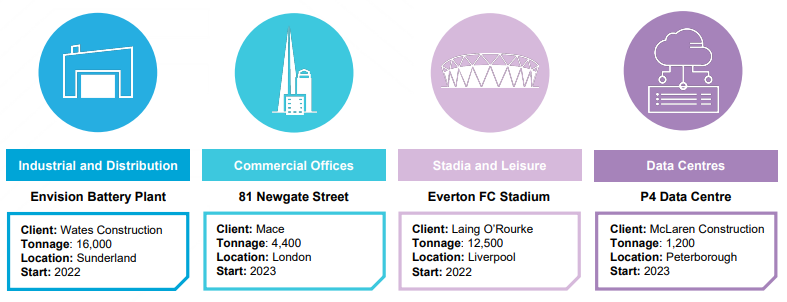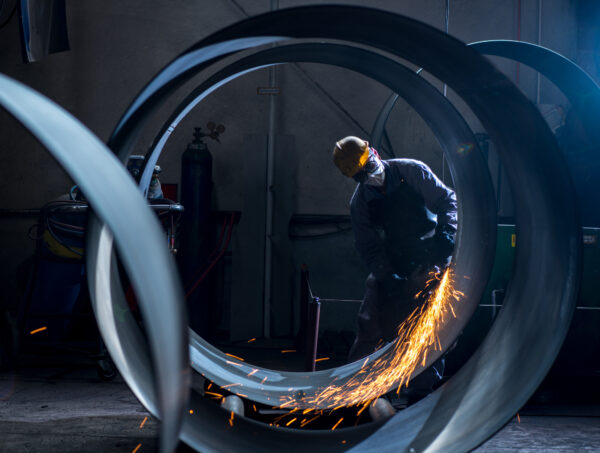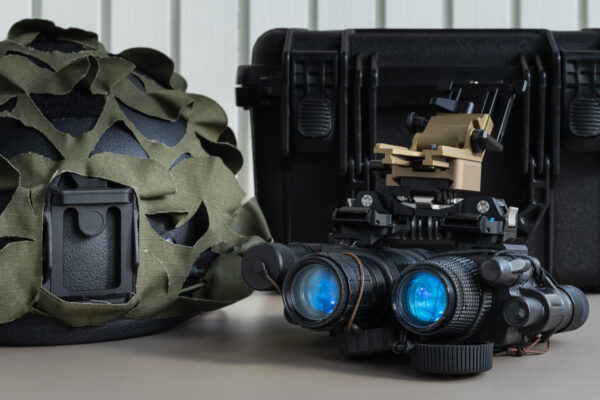Robust and growing markets underpin business case
Severfield operates in large construction and infrastructure markets, which by definition grow annually, leading to an increasing order book, which raises the quality of Severfield’s revenue stream. This predictability allows management to invest in the business with confidence thus generating long-term growth, cash generation and a progressive dividend, which currently yields c 5%. Furthermore, the stock is trading on a lowly FY24e P/E of 7.0x, which is comfortably below the long-term average of 10x, suggesting material upside.
Compelling business case evidenced by delivery
Severfield operates a simple, yet compelling business model, as described in Exhibit 1 below. Investment in infrastructure, either by the public or private sector, is a key driver of revenue and is, by nature, relatively predictable, as we show in Exhibit 2. The real differentiator tends to be within certain sectors where investment can ebb and flow, but in general, overall spending usually increases each year and because Severfield has a strong reputation, its revenue grows faster than the market, suggesting that it tends to take market share. We estimate Severfield enjoys c 15% market share in the UK.
The range of sectors, geographies and clients covered by Severfield offers revenue resilience and the quality of earnings is therefore higher than in many other industries. Furthermore, the business has been well invested, with capital expenditure running at, or ahead of, depreciation for a number of years. This has led to a double-digit post-tax return on average invested capital and strong cash flow generation, allowing Severfield to internally fund the three acquisitions it has undertaken over the last four years. We estimate that net debt to EBITDA will fall to 0.65x by the end of FY24e.
Exhibit 1: Severfield’s compelling business case
|

|
|
|
One example of the support to revenue growth is the UK government’s 2020 National Infrastructure Strategy (NIS), published in November 2020, which set out clear plans for investment across a wide range of sectors in response to a report from the National Infrastructure Commission (NIC) assessing the UK’s infrastructure needs. In the NIS, the government stated that it wanted to deliver an ‘infrastructure revolution’ that would raise the quality of the UK’s infrastructure, generate 250,000 jobs and set the UK on a path to ‘net zero emissions by 2050’. Similar investment plans exist in other regions, notably Europe where the EU’s Green Deal is looking to invest €1tn in infrastructure.
The NIS supports the likelihood that the UK government will continue to invest in infrastructure, which should see the overall level of investment rise each year. The exhibit below details the long-term trend in the value of UK infrastructure at constant prices in the UK, which has grown every year. Given the UK government’s long-term investment plans, it appears likely that Severfield can look forward to a healthy growing market.
Exhibit 2: Market sector net stocks of infrastructure (£m)*
|

|
Source: ONS. Note: *Constant prices (2019=base).
|
Severfield is recognised as the market leader in steel fabrication in the UK and has grown revenue almost every year since 2013. We expect total revenue to increase to almost £500m for the year to March 2023, implying total growth of c 150% over 10 years, or c 12% pa. While most of the growth has been generated organically, we estimate that c £50m (c 17%) was accounted for by the acquisitions of Harry Peers in 2019 and DAM Structures in 2021, both of which generated revenue of just over £20m pa at the time of acquisition.
Underlying operating profit has followed a similar path, growing from £8.9m in 2015 to an expected £31.3m in the year to March 2023, representing growth of more than 300% or c 17% pa as increased revenue has been associated with higher margins. In FY15, Severfield generated an operating margin of 4.5%, which peaked at 8.5% in 2019 ahead of the pandemic, before sliding back to 6.7% in 2022 and an expected 6.4% for FY23. Severfield generally targets an operating margin of c 8–10%, but this is currently reduced to 6–8% to reflect the high steel price environment. However, while the current margin target is lower, the absolute level of profit is broadly the same as Severfield passes through higher costs via its revenue line, which results in a lower overall margin.
We anticipate that both revenue and operating profit will increase in FY24 for two reasons. Firstly, Severfield’s orderbook is at record levels, implying high levels of activity, and secondly, it will benefit from an almost full year contribution from the acquisition of VSCH We forecast further growth in FY25.
Exhibit 3: Revenue 2015–25e (£m)
|
Exhibit 4: Underlying operating profit (ex JV and associates) and margin 2015–25e
|

|

|
Source: Severfield and Edison Investment Research
|
Source: Severfield and Edison Investment Research
|
Exhibit 3: Revenue 2015–25e (£m)
|

|
Source: Severfield and Edison Investment Research
|
Exhibit 4: Underlying operating profit (ex JV and associates) and margin 2015–25e
|

|
Source: Severfield and Edison Investment Research
|
New divisional structure to highlight Modular contribution
Severfield’s main operations are split between two divisions: Commercial and Industrial (C&I) and Nuclear and Infrastructure (N&I). The former accounted for c 81% of group revenue in FY22, while the latter accounted for c 16%. Severfield also has a small but potentially rapidly growing MS division, which generated c £14m of revenue and accounted for c 3% of revenue in FY22. The principal subsidiary in MS is Severfield Products and Processing (SPP), but it also contains an equity accounted JV called Construction Metal Forming (CMF) that generated £35m of revenue. Despite the modest size of MS, its contribution is currently greater than it looks at first glance, and it has the potential to become a material element of the group as the main subsidiary, SPP, moves into profit over the medium term.
Within C&I (66% of group), commercial offices (c 21% of group), industrial and distribution (22%), and Stadia and Leisure all account for around 21–22% of the group, implying that the revenue base is well spread. Data centres, retail and health and education collectively account for around 6% of group revenue and also fall under the C&I umbrella.
In N&I (c 33% of group), nuclear exposure accounts for 14% of revenue and is generated from three subsectors: nuclear new build, nuclear decommissioning and defence. Transport (14%) and power and energy account for the rest of the N&I division with products and processing (1%) falling under the Modular Solutions umbrella.
Exhibit 5: Severfield divisional structure
|
Exhibit 6: Estimated revenue by sector, based on order book (March 2023)
|

|

|
|
|
Source: Severfield and Edison Investment Research
|
Exhibit 5: Severfield divisional structure
|

|
|
|
Exhibit 6: Estimated revenue by sector, based on order book (March 2023)
|

|
Source: Severfield and Edison Investment Research
|
C&I (c 81% of group revenue in FY22; 66% of order book at end FY23)
C&I has been streamlined from three entities into its current form. Part of the rationale for streamlining the business was to reduce the number of points of contact to one, to provide a better, more efficient all-round service to clients and to have better focus and accountability internally. The net results are an enhanced oversight of projects and therefore a clearer path to support. Management anticipates that it will also drive enhanced market competitiveness. The clearer points of contact have led to a unified approach to project delivery, better health and safety outcomes and a clearer understanding of issues relating to ESG across all of Severfield’s projects, according to management.
The exhibit below shows examples of key projects currently underway, all of which are being driven by external growth drivers, and that are likely to lead to additional work in the future, all reflected in the growing orderbook discussed later in the note. For example, in the industrial and distribution subsector, investment in the green energy transition is driving renewable energy, particularly in the area of electric vehicles. The Envision Battery Plant mentioned is a 16,000 tonne, c £80m contract to supply steel to the project in Sunderland. Severfield has already secured a c £70m project to build the SeAH Monopile Factory (wind energy) in Teesside and other significant potential deals are in the pipeline.
Exhibit 7: Examples of projects underway in C&I
|

|
|
|
In commercial offices, demand has bounced back after the COVID-19 hiatus as property owners and occupiers are demanding space that increasingly complies with ESG requirements and the drive to net zero emissions by 2050. Consequently, Severfield is working on the first fully electricity powered office building at 81 Newgate Street, London, and has secured several other significant projects at Harcourt Square, Salisbury Square and 105 Victoria Street. Each of these projects are worth more than £15m to Severfield and, in some cases, double this value.
In stadia and leisure, which for Severfield includes film studios, the company is currently working on the expansion of the Pinewood Studios (c £35m contract) and the new Everton Football Club Stadium in Liverpool (c £65m contract) and has secured contracts for the Excel Exhibition Centre in London (c £25m) and the new Sunset Studios in Hertfordshire (c £60m). The pipeline includes the Etihad North Stand and Hertswood Studios, which are both expected to begin in 2024 or 2025.
Finally in data centres, another strong sector currently, Severfield is on site in Peterborough at the P4 Data Centre, has secured the LHR11 Data Centre at Heathrow and has numerous projects in the pipeline in the UK and Ireland.
N&I (c 16% of group revenue in FY22; 33% of order book at end FY23)
In addition to the growth expected in the C&I division, substantial revenue growth is likely due to Severfield’s exposure to the UK’s nuclear industry. The UK government estimates that decommissioning the original fleet of Magnox nuclear power stations and dealing with the associated waste will take 120 years to complete and is likely to cost £129bn across the 17 sites. Sellafield in Cumbria is likely to be the site that attracts the most investment (c 75% of the total) as this is where all of the UK’s waste plutonium (also known as special nuclear material, SNM) is located.
Exhibit 8: Government spending on nuclear facilities by location
|

|
|
|
This is an exciting sector for Severfield, not least because of the scale of the opportunity, but also because Severfield was recently selected as one of the two key delivery partners (KDPs) to deliver substantial work under the 17-year Programme and Project Partners (PPP) framework. The KDP status is beneficial because it gives much greater certainty over revenue opportunities, allows for risk and opportunity share with certainty of cost recovery and implies much reduced competition for work. In total, the PPP comprises 25 major projects with a total spend of £7bn.
Since 2021, Severfield has been working at Sellafield on a project called the Site Ion Exchange Plant (SIXEP) Continuity Plant (SCP), which is a £13m contract, and it recently commenced work on the Sellafield Product and Residue Store Reprocessing Plant (SRP), which is a £15m contract to provide the steelwork for the new facility that will house the SNM. In total, SRP is a £1.5bn project that is due to complete in 2027. Preparation for and execution to date of the contracts already underway is likely to have been a key driver of Severfield being awarded one of the two KDP positions.
In addition to the decommissioning-related revenue, Severfield generates revenue from the defence sector and the nuclear new build sector. The key revenue driver in defence is the maintenance of the UK’s Trident nuclear deterrent and the drive to keep the UK armed forces at the forefront of technology. In nuclear new build, the key drivers are the national energy supply shortage as older power stations are taken out of production, and the UK government’s commitment to net zero emissions by 2050.
Examples of the work currently being undertaken in the defence sector are the new £1.8bn nuclear warhead assembly and disassembly facility at the Atomic Weapons Establishment (AWE) at Aldermaston, which is a £55m contract, and the construction of ancillary steelwork at the new nuclear power station at Hinkley Point, which is a £25m contract to design, fabricate and erect over 2,200 tonnes of access platforms and mechanical handling steel.
Exhibit 9: Examples of nuclear projects already secured by sub-sector
|

|
|
|
MS (c 3% of revenue, plus an equity accounted JV)
The principal subsidiary in MS is SPP, which is split into three business areas:
1.
Severstor: fabricator of specialist equipment housings for critical electrical equipment and switchgear.
2.
Supply Chain: raw material fabrication and systems for the modular (housing and buildings) industry including steel cassettes and frames.
3.
Bulk Handlings Solutions: fabricator of repeatable products including silo discharging systems.
MS generated revenue of £14m in FY22. It also contains the equity accounted 50/50 JV CMF, a manufacturer of steel decking and composite metal flooring, which generated a further £35m. Collectively, the two generated revenue of £49m and c £2.8m of operating profit. However, the company is confident that the two businesses could potentially double revenue and more than double the combined operating profit because there is scope to grow the operations. SPP is currently subscale and loss-making to the tune of c £1.4m, but management believes it has the potential to generate a profit of up to £4m per annum in the medium term.
Severfield’s FY22 profits by source
Severfield’s profits are primarily generated by the two main divisions, C&I and N&I. However, the MS division contributes more than is initially obvious at first glance. Severfield reported group underlying operating profit in FY22 of £26.9m, after the receipt of its 50% share of a £2.8m distribution (ie £1.4m) from its CMF JV in the MS division, and, accounting for a £1.4m loss generated by SPP, its fully owned subsidiary in MS.
Moving further down Exhibit 10 below, Severfield reported a £0.6m post tax share of profits from the CMF JV and a £0.8m share of profit from its Indian JV, JSSL. After finance costs of £1.1m, Severfield generated underlying PBT of £27.1m.
Exhibit 10: Summary of Severfield’s profit streams, FY22
|
£m |
Underlying operating profit, C&I and N&I (ex MS and JV distribution) |
26.9 |
Share of JV distribution, including in operating profit |
1.4 |
Underlying operating profit, ex MS |
28.3 |
MS operating profit/(loss) (SPP only) |
(1.4) |
Group underlying operating profit |
26.9 |
JVs – post tax contribution |
|
MS (CMF) |
0.6 |
India (JSSL) |
0.8 |
Finance costs |
(1.1) |
Underlying group PBT |
27.1 |
|
Underlying operating profit, C&I and N&I (ex MS and JV distribution) |
Share of JV distribution, including in operating profit |
Underlying operating profit, ex MS |
MS operating profit/(loss) (SPP only) |
Group underlying operating profit |
JVs – post tax contribution |
MS (CMF) |
India (JSSL) |
Finance costs |
Underlying group PBT |
£m |
26.9 |
1.4 |
28.3 |
(1.4) |
26.9 |
|
0.6 |
0.8 |
(1.1) |
27.1 |
Source: Severfield, Edison Investment Research
Project Horizon, embracing technology for growth
In 2023, Severfield’s management introduced ‘Project Horizon’, which is an ambitious, transformational plan to improve efficiency and the quality of the service offering to clients, while boosting capacity. The project has a dedicated team of 14 full-time members and is expected to be self-funding via the associated cost savings.
The aim of the project is to maximise the automation of Severfield’s operations and project delivery through a series of initiatives to standardise systems and processes. Project Horizon is a long-term initiative to ensure that Severfield remains the leader in its field and is set alongside other operational improvement programmes. It should result in a higher revenue and market share and lower overall unit costs, although it is hard for us to calibrate measurable outcomes as efficiencies are not reported.
Exhibit 11: Overview of Project Horizon
|

|
|
|
The overall project consists of more than 100 sub-projects that range over eight separate activities of the group, including estimating, design and detailing and procurement, to production, construction and project management. The workstreams are also categorised and prioritised into short-, medium- or long-term projects.
An example of a ‘design and detailing’ stream is the creation of engineering apps, designed to accelerate the time taken to convert an enquiry into a full design that can be used in the procurement process. Another example, which falls under the ‘production’ stream, is a project to improve ‘quality assurance’, which speeds up the production of quality assurance test certificates.
Order book has materially expanded and diversified
Over the last five years, Severfield’s UK and Europe order book has grown materially and is now increasingly diversified. Exhibit 12 shows these two trends clearly. Firstly, the absolute size of the order book has more than doubled from just £230m in November 2018 to £508m in March 2023. We understand that c £70m of the increase relates directly to steel price increases that Severfield passes through. However, even splitting this inflation out of the numbers, the book has grown by more than 80% in the period, a compound annual growth rate of c 15%.
Secondly, the diversification in the order book has improved materially. In 2018, commercial offices accounted for 60% with a typical c 18-month construction cycle. This section of the order book remains of a similar size in absolute terms but is now less than one-third of the total order book. By contrast, four other sectors each account for c 15–17% of the order book and several of these, particularly in nuclear and transport, will be contracts that have been won that are part of much longer-term projects, such as nuclear de-commissioning and HS2. There are other aspects that give cause for optimism. In the 2022 Autumn Statement, the UK government chose not to cut or cancel any infrastructure projects despite pressure to do so. This included maintaining HS2. The government has other initiatives including the £850m Automotive Transformation Fund, which is expected to support the construction of battery gigafactories and zero-carbon vehicle production facilities. These initiatives, and other growth industries such as film and TV, are likely to require built infrastructure, which bodes well for the future of Severfield, and are already being seen in the order book and revenue streams.
Exhibit 12: Severfield’s order book by period and sector (£m)
|

|
Source: Severfield, Edison Investment Research
|
Voortman M&A offers an enhanced gateway to Europe
In March 2023, Severfield announced the acquisition of Dutch steel fabrication company VSCH for a total cash consideration of €24m (c £21.1m). There was no deferred consideration element to the deal. The consideration represents an FY21 revenue multiple of 0.3x and a c 5.3x multiple of normalised EBITDA of €4.5m. In the previous three years, VSCH had generated an EBITDA of between €4.5m and €5.5m. If the higher profit figure was used, the historical multiple would decline to 4.8x. The VSCH acquisition is the third such deal in the last four years, following the purchase of Harry Peers in 2019 and DAM Structures in 2021. Harry Peers was the first acquisition since 2007.
Exhibit 13: Severfield M&A activity
Target |
Date |
Consider’n
(£m) |
Rev
(£m) |
EBITDA |
Location |
Sales
multiple (x) |
EBITDA
multiple (x) |
Comment |
Voortman Steel Construction Holdings |
Apr-23 |
21.1 |
64.9 |
3.9 |
The Netherlands |
0.3 |
5.3 |
Entrance into north European construction markets. |
DAM Structures |
Feb-21 |
17.0 |
22.3 |
3.5 |
Yorkshire, UK |
0.8 |
4.9 |
Access to new customers in construction and rail sectors. £12m initially, plus £7m deferred. Up to £8m performance related additionally. |
Harry Peers & Co |
Oct-19 |
24.0 |
21.2 |
4.0 |
Lancashire, UK |
0.8 |
6.0 |
Access to clients in regulated markets like nuclear, process industries and power generation. Conditional deferred consideration of up to £7m. |
Total |
|
62.1 |
108.4 |
11.4 |
- |
0.6 |
5.4 |
|
Source: Severfield, Edison Investment Research
VSCH is a one of the market leaders in the Dutch steel fabrication market, focusing on the industrial, commercial and residential sectors, and in 2021 it generated revenue of €74m (£64.9m). The deal gives Severfield its first manufacturing facility in mainland Europe and access to new geographical markets, notably in the Benelux countries, Germany, Switzerland and Scandinavia. It will target some of the sectors already addressed by VSCH, expanding its interest into battery plants, distribution and power and energy and also move into new sectors for VSCH such as data centres, stadia and transport infrastructure.
The deal gives Severfield access to new clients and the opportunity to offer a wider range of services to its existing clients. It offers opportunities in the high-growth sectors of electricity and distribution, and VSCH has capabilities in design and build (turnkey) solutions for simpler structures. VSCH is co-located with another separate Voortman business that focuses on machinery manufacturing, which offers Severfield, via VSCH, an opportunity to collaborate on robot technology, proprietary fabrication software and bespoke equipment.
VSCH operates from two bases in the Netherlands, one in the east in ‘Rijssen and one in the west in Maassluis, and employs c 150 people, mainly at the two hubs. It is organised into three divisions, described in the exhibit below, with the largest being VSC, which is most similar to the core operations of Severfield. VDB is focused on the design and build of relatively simple tailormade turnkey buildings. This is a new activity for Severfield and its capability is expected to be cross-sold to Severfield’s existing UK client base. VDH is largely exposed to the fast-growing energy sector, which is a new area for Severfield.
Exhibit 14: VSCH – divisional summary
|

|
|
|
The VSCH operations are well invested, as illustrated by its highly efficient facilities, which produce c 15–20,000 tonnes of output per annum. Like Severfield, it has a highly regarded reputation for quality and reliability, which implies that, culturally, it fits well.
Severfield estimates that the total serviceable addressable market (SAM) in the Netherlands is €1.3bn out of a total addressable market (TAM) of c €2.5bn (in 2021). The TAM includes all sectors: industrial, commercial, residential, energy and utilities and infrastructure. The SAM excludes infrastructure. VSCH reported 2021 revenue of €74m, which implies that it has a c 5% market share of the SAM and that there is considerable scope to expand.
Severfield believes that Voortman is the fifth largest steel fabrication specialist in the Netherlands and commands a c 8% market share in a market where no competitor has more than a c 10% share. Now that VSCH is part of the Severfield Group, it has the potential to grow revenue faster and is probably the market leader in the Netherlands once combined with Severfield’s existing European operations. For example, VSC, the largest division, is expected to grow further in the Netherlands, and to expand into neighbouring countries. VDB will have the opportunity to expand its turnkey offerings to SMEs in the Netherlands and other EU countries, as well as capitalising on existing relationships with Severfield clients. VDH is expected to capitalise on the energy transition trend in the electricity industry where Severfield anticipates high growth rates over a prolonged period. Examples of projects undertaken and the pipeline of opportunity are outlined in Exhibits 16 and 16 below.
Exhibit 15: Examples of VSCH projects
|
Exhibit 16: VSCH pipeline of opportunity
|

|

|
|
|
|
Exhibit 15: Examples of VSCH projects
|

|
|
|
Exhibit 16: VSCH pipeline of opportunity
|

|
|
|




























